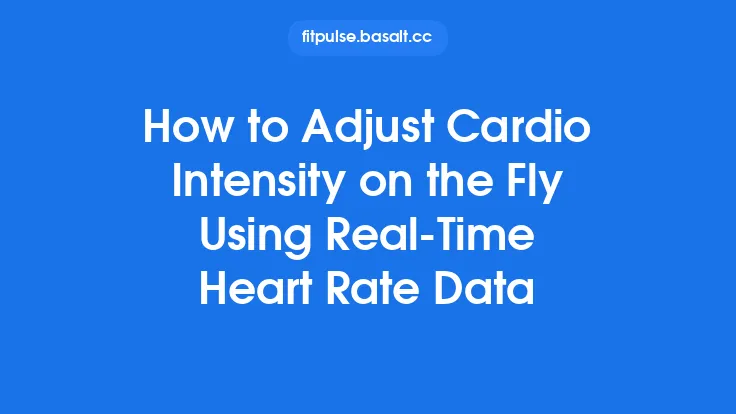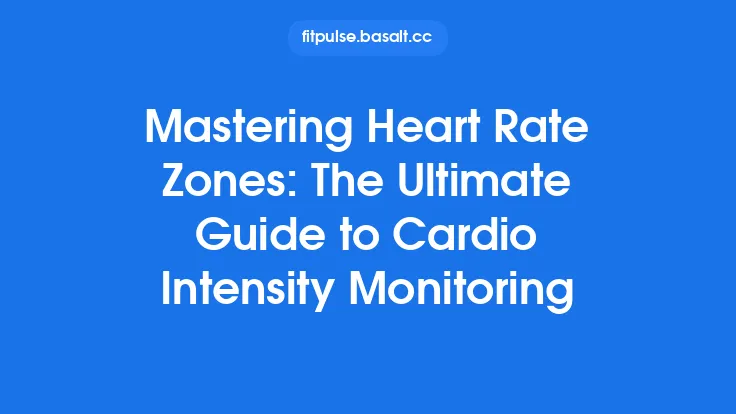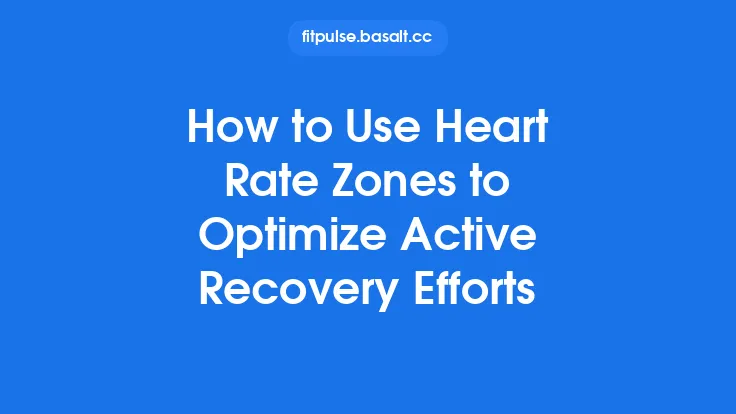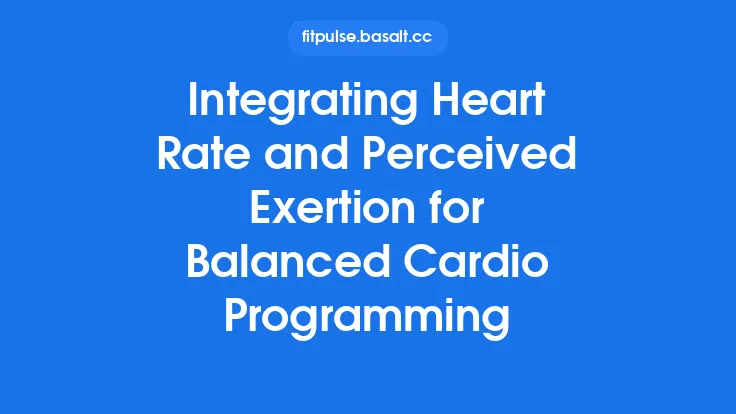When it comes to fine‑tuning cardio workouts, many athletes and coaches rely on heart‑rate zones or the subjective feel of effort. While those tools are valuable, they capture only a snapshot of the cardiovascular system at a single moment. Heart Rate Variability (HRV) offers a complementary, data‑rich perspective that reflects the balance of the autonomic nervous system (ANS) over time. By listening to the subtle beat‑to‑beat fluctuations in your heart, you can gauge readiness, adapt training load, and ultimately improve the quality of every cardio session.
Understanding Heart Rate Variability
HRV is the physiological phenomenon of variation in the time interval between consecutive heartbeats, known as R‑R intervals. Rather than a metronomic tick, a healthy heart exhibits a dynamic rhythm that changes from beat to beat. This variability is driven primarily by the two branches of the ANS:
- Parasympathetic (vagal) activity – promotes relaxation, recovery, and energy conservation. It shortens the interval between beats when the body is at rest.
- Sympathetic activity – prepares the body for action, increasing heart rate and reducing variability during stress or intense exercise.
A higher overall HRV generally indicates a dominant parasympathetic tone and a well‑recovered state, whereas a suppressed HRV suggests sympathetic dominance, fatigue, or insufficient recovery.
Why HRV Matters for Cardio Conditioning
- Recovery Insight – HRV provides an objective measure of how well the body has recovered from previous training, sleep, nutrition, and life stressors.
- Readiness Detection – Fluctuations in HRV can flag days when the nervous system is not primed for high‑intensity work, helping you avoid overreaching.
- Individualized Load Management – Because HRV is highly personal, it allows you to tailor cardio volume and intensity to your unique physiological state rather than relying on generic percentages.
- Long‑Term Adaptation Tracking – Trends in HRV over weeks and months can reveal improvements in aerobic capacity, autonomic balance, and overall cardiovascular health.
Establishing Your Personal HRV Baseline
Before HRV can guide your cardio sessions, you need a reliable baseline that reflects your typical, well‑recovered state.
- Consistent Measurement Timing – Record HRV each morning, ideally within the first five minutes after waking, while still lying supine. This minimizes external influences such as posture changes, caffeine, or recent activity.
- Sufficient Sample Size – Collect at least 7–14 consecutive days of data to smooth out day‑to‑day noise and capture a stable average.
- Standardized Conditions – Use the same device, measurement position, and environment (quiet, temperature‑controlled room) each day.
- Data Cleaning – Exclude recordings with obvious artifacts (e.g., movement, premature beats) or those taken after poor sleep or illness, as they can skew the baseline.
Once you have a robust baseline, you can express daily HRV values as a percentage of that baseline or as a z‑score (number of standard deviations from the mean). These relative metrics are more actionable than raw millisecond values.
Key HRV Metrics and What They Tell You
| Metric | Typical Calculation | Primary Insight |
|---|---|---|
| RMSSD (Root Mean Square of Successive Differences) | Square root of the mean of the squared differences between adjacent R‑R intervals | Parasympathetic activity; highly responsive to short‑term changes in recovery |
| SDNN (Standard Deviation of NN intervals) | Standard deviation of all normal-to-normal intervals over the recording period | Overall variability; reflects both sympathetic and parasympathetic influences |
| pNN50 / pNN20 | Percentage of successive intervals differing by >50 ms (or >20 ms) | Vagal tone; useful for longer recordings |
| LF/HF Ratio | Power in low‑frequency band (0.04–0.15 Hz) divided by high‑frequency band (0.15–0.40 Hz) | Balance between sympathetic (LF) and parasympathetic (HF) activity – interpret with caution, as the ratio can be misleading in short recordings |
| HF Power (ms²) | Spectral power in the high‑frequency band | Direct marker of vagal modulation |
For most cardio‑focused athletes, RMSSD is the preferred metric because it is less affected by breathing patterns and can be reliably measured in a 1‑minute snapshot.
Day‑to‑Day HRV Trends and Recovery Status
After establishing a baseline, daily HRV readings can be interpreted using simple thresholds:
| HRV Relative to Baseline | Interpretation |
|---|---|
| ≥ 100 % (or +1 SD) | Excellent recovery; ready for high‑intensity cardio or longer sessions |
| 95 %–99 % | Good recovery; moderate‑to‑high intensity is appropriate |
| 90 %–94 % | Slight fatigue; consider reducing volume or intensity |
| < 90 % | Significant fatigue or stress; prioritize recovery, low‑intensity work, or rest |
These ranges are guidelines; individual variability means you should adjust thresholds based on how your body responds over time.
Using HRV to Adjust Cardio Session Volume
1. Volume Scaling
When HRV is high, you can safely add 10–20 % more minutes or distance to your planned cardio session. Conversely, a low HRV day calls for a proportional reduction. For example:
- High HRV (≥ 100 %) – Add 15 % extra minutes to a steady‑state run or bike ride.
- Moderate HRV (95 %–99 %) – Stick to the planned volume.
- Low HRV (< 90 %) – Cut volume by 20 % or replace the session with a light active‑recovery activity (e.g., easy walk, gentle swim).
2. Session Frequency
If you notice a pattern of consecutive low‑HRV days, consider spacing high‑intensity cardio sessions further apart (e.g., every 4–5 days instead of every 2–3 days) until HRV stabilizes.
3. Recovery Interventions
On low‑HRV days, incorporate proven recovery tools—hydrotherapy, targeted mobility work, or a short nap—to accelerate autonomic rebound before the next cardio effort.
HRV‑Guided Intensity Selection for Different Cardio Modalities
| Modality | HRV‑Based Intensity Decision |
|---|---|
| Steady‑State Endurance (e.g., long run, bike ride) | Use HRV to set total duration. High HRV → longer ride; low HRV → shorter, easy‑pace effort. |
| Interval Training (e.g., HIIT, sprint intervals) | Reserve high‑HRV days for demanding interval blocks (e.g., 6 × 30 s all‑out sprints). On moderate HRV days, reduce the number of intervals or increase rest periods. |
| Low‑Impact Cardio (e.g., rowing, elliptical) | On low‑HRV days, keep intensity in a comfortable zone (≈ 50–60 % of perceived effort) while still achieving movement volume. |
| Cross‑Training (e.g., circuit cardio, dance) | Use HRV to decide whether to push the cardio component hard or treat the session as a skill‑focused, lower‑intensity workout. |
The key is to let HRV dictate how much you push, not necessarily which activity you choose. If a particular modality is essential for your training plan, HRV helps you modulate its load rather than skip it entirely.
Integrating HRV into Periodized Cardio Plans
A periodized cardio program typically cycles through phases of base building, intensity peaks, and recovery. HRV can be woven into each phase:
- Base Phase – Use HRV to maintain consistent volume while monitoring for early signs of overload. Small weekly HRV declines may signal the need for an extra recovery week.
- Build/Intensity Phase – Allow HRV to dictate the timing of high‑intensity blocks. If HRV spikes after a recovery day, schedule a hard interval session; if it stays suppressed, extend the recovery period.
- Taper/Peak Phase – As competition approaches, aim for a gradual HRV increase (often 5–10 % above baseline) indicating full recovery and readiness for peak performance.
- Off‑Season/Active Recovery | HRV serves as a benchmark for overall health. Persistent low HRV over weeks may suggest lifestyle adjustments (sleep, stress management) before re‑entering structured cardio training.
By aligning HRV trends with the macro‑cycle, you ensure that the autonomic system is in sync with the training load, reducing the risk of chronic fatigue or injury.
Practical Tips for Accurate HRV Measurement
- Choose a Reliable Sensor – Chest‑strap ECG sensors (e.g., Polar H10) or dedicated finger‑clip devices provide the most accurate R‑R intervals. Optical wrist sensors can be acceptable if validated for HRV.
- Keep Record Length Consistent – A 5‑minute supine recording is the gold standard for daily HRV. Shorter 1‑minute recordings can be used if the device’s algorithm is validated for RMSSD.
- Control Breathing – While spontaneous breathing is fine for most athletes, a controlled breathing rate (≈ 0.1 Hz, or 6 breaths per minute) can reduce measurement noise if you need high precision.
- Avoid Confounders – No caffeine, alcohol, or heavy meals within 2 hours of measurement. Also, postpone HRV testing after a night of poor sleep until you have a clear picture of recovery trends.
- Use Automated Analysis – Apps that automatically calculate RMSSD and flag artifacts reduce user error and improve data consistency.
Common Misinterpretations and How to Avoid Them
| Misinterpretation | Why It’s Wrong | Correct Approach |
|---|---|---|
| “A single low HRV reading means I’m sick.” | HRV is sensitive to many acute stressors (e.g., a late night, dehydration). | Look for patterns over 2–3 days before concluding illness. |
| “Higher HRV always equals better fitness.” | Chronic high HRV can also indicate under‑training or insufficient stimulus. | Combine HRV trends with performance metrics (pace, power) to assess fitness. |
| “HRV can replace all other monitoring tools.” | HRV reflects autonomic balance but not mechanical load or technique. | Use HRV alongside perceived effort, power output, or distance metrics for a holistic view. |
| “The LF/HF ratio is the best indicator of stress.” | LF/HF is heavily influenced by breathing and measurement length, making it unreliable in short recordings. | Prioritize RMSSD for day‑to‑day decisions; use LF/HF only in research‑grade, long‑duration recordings. |
Putting It All Together: A Sample Week of HRV‑Driven Cardio
| Day | HRV (Relative) | Decision | Cardio Session |
|---|---|---|---|
| Mon | 102 % | High HRV – add volume | 60 min steady‑state run (10 % longer than usual) |
| Tue | 96 % | Maintain plan | 45 min moderate bike, normal intensity |
| Wed | 88 % | Reduce load | 30 min easy swim, low intensity |
| Thu | 94 % | Slightly lower volume | 40 min elliptical, keep intensity moderate |
| Fri | 101 % | High HRV – schedule interval | 6 × 30 s sprint intervals with 2 min rest |
| Sat | 92 % | Recovery day | 45 min brisk walk, focus on mobility |
| Sun | 98 % | Normal volume | 50 min trail run, comfortable pace |
Notice how the plan flexes around HRV fluctuations, preserving training stimulus on good days while protecting the body on lower‑HRV days. Over several weeks, you’ll likely see a gradual upward shift in baseline HRV, reflecting improved autonomic balance and cardio fitness.
Future Directions and Emerging Research
- HRV‑Based Machine Learning Models – Researchers are developing algorithms that combine HRV with sleep, nutrition, and stress data to predict optimal training windows with higher precision.
- Wearable ECG Integration – Next‑generation wearables are moving from optical PPG to continuous ECG, delivering clinic‑grade HRV data in everyday settings.
- HRV‑Guided Adaptive Training Platforms – Some training apps now automatically adjust cardio prescriptions in real time based on nightly HRV uploads, reducing the need for manual decision‑making.
- Longitudinal HRV‑Fitness Correlations – Large cohort studies are confirming that sustained HRV improvements correlate with reduced cardiovascular disease risk, reinforcing HRV’s value beyond performance.
Staying abreast of these advances will allow you to refine your HRV‑driven cardio strategy as technology and science evolve.
By incorporating HRV into your cardio routine, you gain a window into the nervous system’s readiness that no heart‑rate zone or perceived exertion scale can provide on its own. With consistent measurement, thoughtful interpretation, and strategic adjustments to volume and intensity, HRV becomes a powerful ally for optimizing performance, preventing overtraining, and fostering long‑term cardiovascular health.





